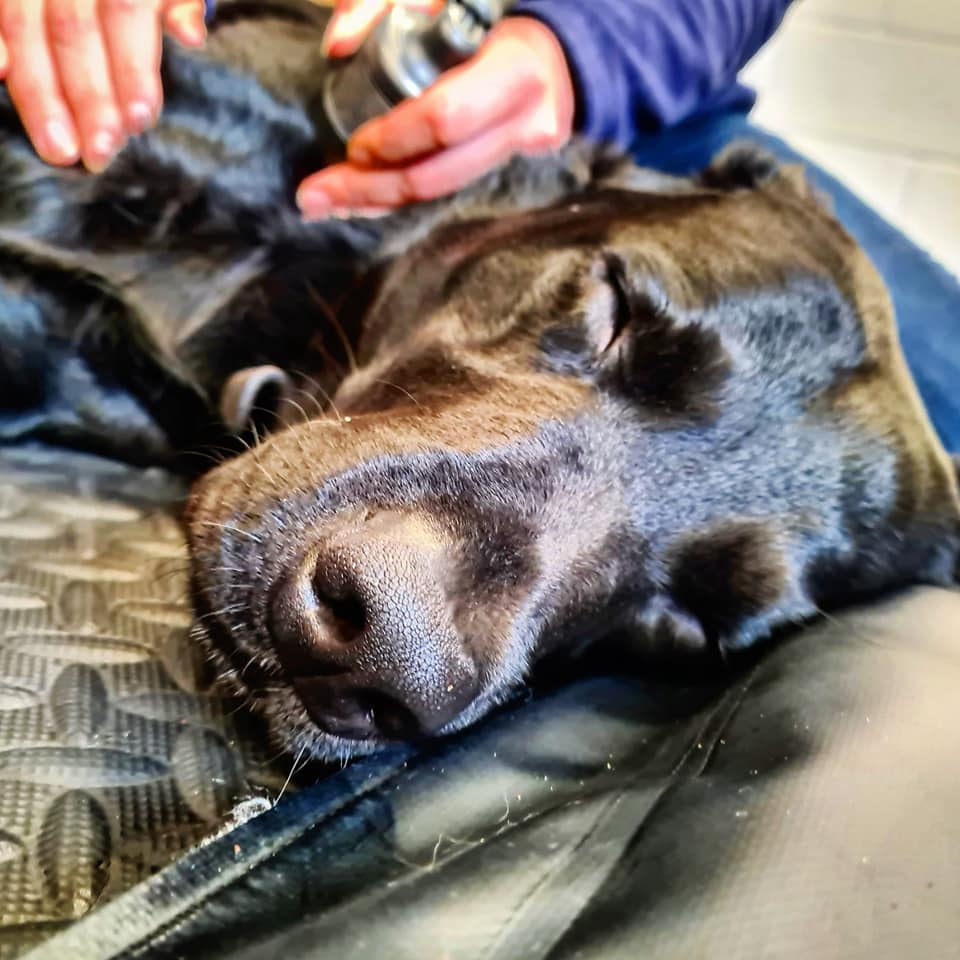The Gold Standard in Physiotherapy and Hydrotherapy for dogs
The Gold Standard in Physiotherapy and Hydrotherapy for dogs

Osteoarthritis is a very common problem in small animals, as it is in humans. It has been estimated that around 4 in every 5 of dogs will be affected by osteoarthritis at some point in their lives.
The condition causes long term degeneration of joints and involves many tissues including cartilage (the white, shiny, low-friction joint surfaces), bone under the cartilage, joint capsule and fluid in the joint (synovial fluid).
Unlike humans where osteoarthritis is usually related to ageing and ‘wear and tear’ of joints, osteoarthritis in dogs usually has a specific underlying cause and is therefore often seen earlier in life. Underlying causes can include developmental conditions such as elbow dysplasia or hip dysplasia, ligament rupture and traumatic problems such as broken bones involving a joint.
Once osteoarthritis has started in a joint it cannot be cured and will affect an animal for the rest of his or her life. However, the osteoarthritis can be broadly divided into two forms (1) chronic active osteoarthritis which causes pain and lameness and (2) chronic silent osteoarthritis which may cause stiffness but not pain or lameness.
Affected dogs may show signs of:
Joints affected with osteoarthritis are often thickened with a restricted range of movement and muscles on the affected limb are invariably wasted or reduced in size. Detecting evidence of pain on manipulation of arthritic joints is an important feature that helps distinguish the active and silent forms of the disease.
X-rays are the most common method of diagnosing osteoarthritis and ruling out other possible causes of joint pain and lameness. Images from the X-rays typically include the formation of abnormal bone around the joint.
Since osteoarthritis cannot be easily cured, the aim of treatment is to convert chronic active osteoarthritis into chronic silent osteoarthritis.
There is no single approach to treatment that is successful in every case, and most dogs need a multi-modal approach.
Medical Management
Since osteoarthritis can be painful, painkillers are usually prescribed. In the long term these can often be reduced or discontinued, although in some animals long term medication is needed. Although long term medication can have a risk of side effects, this risk must be balanced against recurrence of pain from the osteoarthritis if the medication is not given.
Exercise Management
Exercise levels are very important. Initially when a joint is painful it is necessary to decrease exercise, often to just short walks on the lead. In the long term, it is very important to gradually increase exercise as much as possible. This allows pets to remain fit and active and enjoy a good quality of life. However, excessive activity must be avoided since this could cause pain to recur. There is no golden rule as to how much exercise an animal with osteoarthritis can have, since all patients are different; instead, exercise levels need to be tailored to the individual animal.
Weight Management
Weight control is also very important. Pets that are an ideal weight have fewer painful episodes and less progression of osteoarthritis than overweight animals. Prescription diets may be needed in some animals to help with weight loss.
Supplements
Long term food supplements such as glucosamine, chondroitin and green lipped muscle extract have been proposed to help reduce the progression of osteoarthritis in the joint. Whilst these products are very popular and are safe, it should be borne in mind that there is very little proof of their effectiveness.
Foods containing omega-3-fatty acids can have a natural anti-inflammatory action which may help to relieve discomfort associated with osteoarthritis. Supplements (such as evening primrose oil) or special prescription diets can be used.
Complementary Therapies
Physiotherapy and hydrotherapy can be useful in some pets to help maintain fitness and muscle mass.
Some arthritic dogs can benefit from regular hydrotherapy sessions, which can help improve joint range of movement and maintain muscle mass. Swimming, as a non-weight bearing exercise, can also be a useful activity to assist with weight loss, when normal exercise may not be well tolerated.
These therapies need to be discussed carefully with your vet before being started, to avoid making painful joints worse.
Rehabilitation is a process which aims to maximise patient mobility and wellbeing, returning them to their usual way of life following illness, injury or surgery. We restore pets to normal function (or as close as is possible), efficiently and safely using a wide variety of physiotherapeutic techniques.
Injury and even surgery can disrupt the body’s equilibrium in all sorts of direct and indirect ways. Even a pet’s own protective responses such as the inflammatory process can overwhelm and inhibit healing so one objective of rehabilitation is to reduce this level of inflammation. During rehabilitation, we also aim to boost the circulatory system, improve muscle function, increase range of motion within joints, and stimulate innate pain-relieving mechanisms.
With a committed and planned rehabilitation programme, pets can recover more quickly, realise better outcomes and avoid much pain and discomfort.
The best rehabilitation programmes consider the whole pet, not just the area of injury; we target and improve multiple systems throughout the body without forgetting the invaluable healing effects of boosting mental wellbeing too. From the wound healing properties of laser treatment, and the muscle strengthening of hydrotherapy, to the circulation boosting effects of massage, we will devise a rehabilitation programme to match a pet’s specific requirements.
Our friendly and skilled physiotherapists are ready to help you and your dog with their rehabilitation.
The content on this page is for advice and information only and does not represent veterinary guidance or direction. Please always consult a veterinary surgeon if you are worries about your dog.